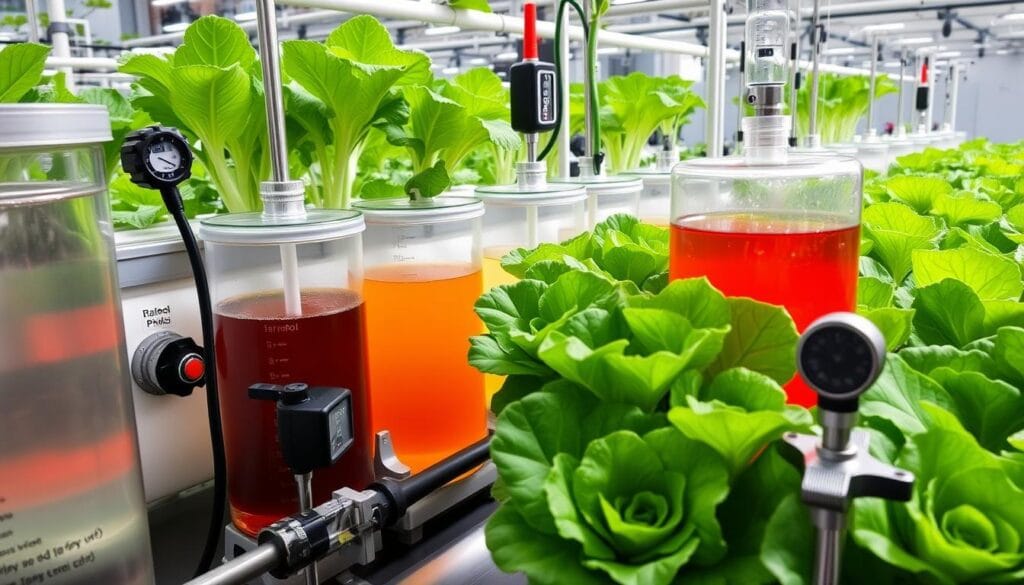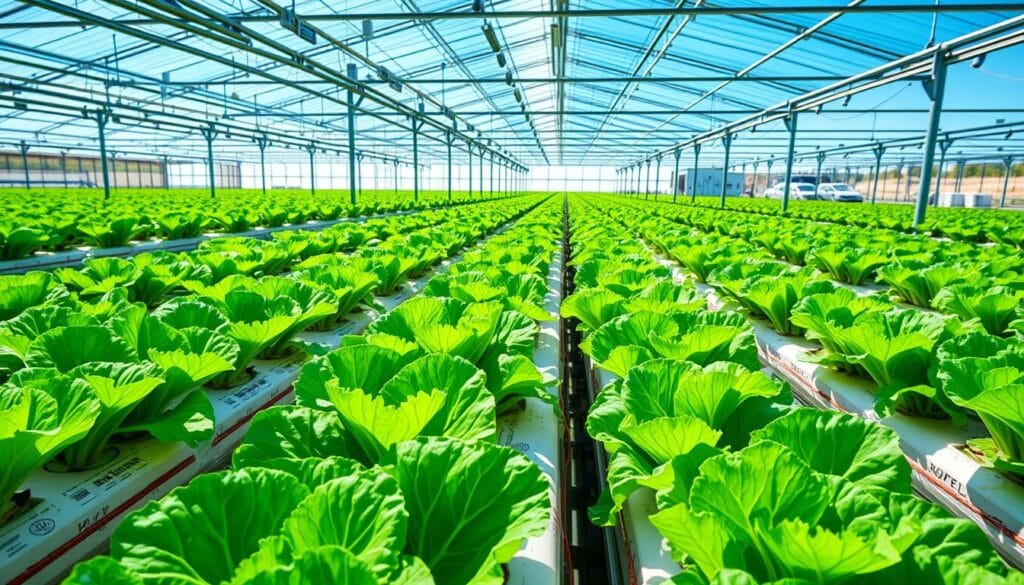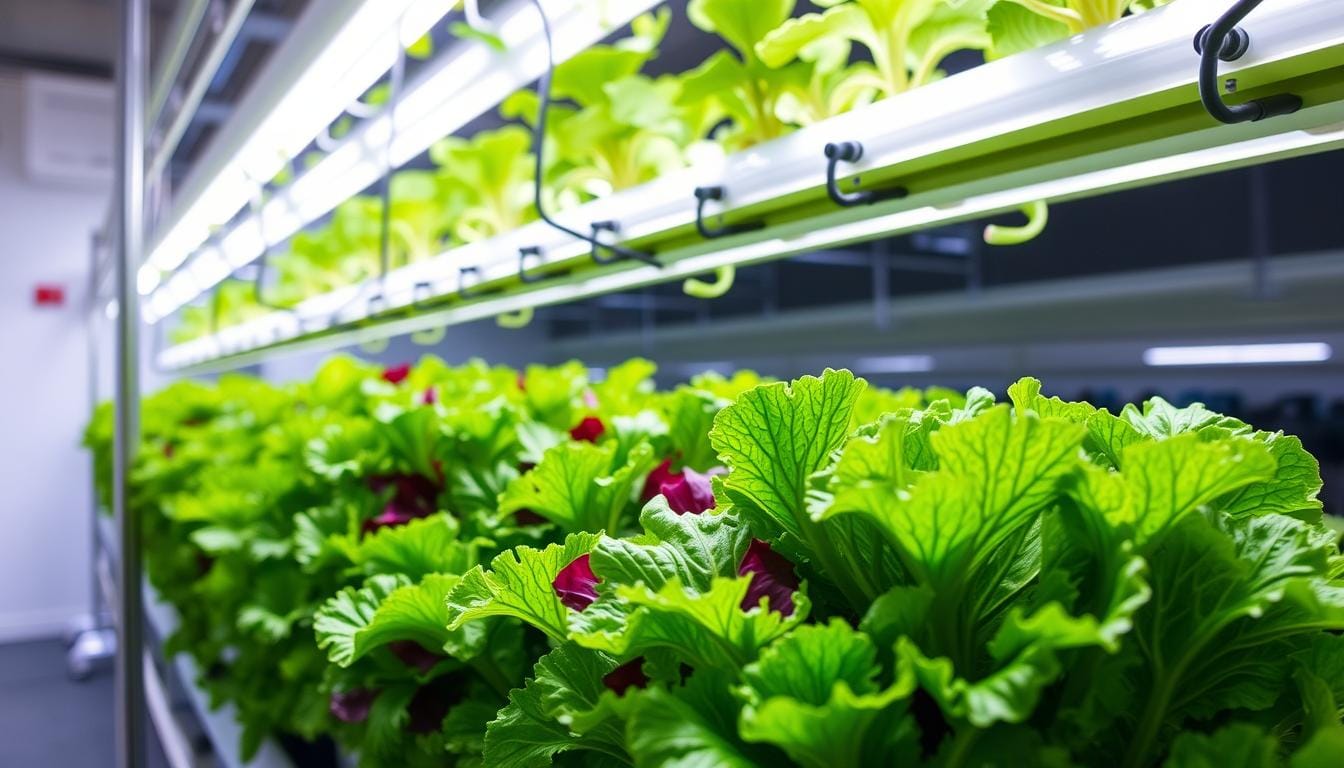Rafael lettuce hydroponic success has always been a passion of mine. Growing my food in the city led me to hydroponic farming, and cultivating Rafael lettuce was a breakthrough. It’s efficient, saving both water and space, and the results are truly remarkable.
In this guide, I’ll share the 6 best practices for growing Rafael lettuce hydroponically. These tips are great for both new and experienced urban farmers. They help you get the most out of this nutritious crop, all year round.
Key Takeaways
- Hydroponic systems can save up to 90% of water compared to soil farming for Rafael lettuce
- Rafael lettuce grown hydroponically can be harvested 15-20 days faster than soil-grown
- Hydroponic systems offer higher yields of Rafael lettuce, up to 4-5 lbs/ft²
- Hydroponics provides year-round growing solutions and space-efficient cultivation
- Optimal nutrient management is crucial for healthy, thriving Rafael lettuce plants
Understanding Rafael Lettuce Hydroponic Cultivation Basics
Cultivating leafy greens like Rafael lettuce with hydroponics is becoming more popular. It’s used in indoor vertical farming and controlled environment agriculture. Hydroponics uses nutrient-rich water to feed plants, without the need for soil. This approach provides numerous advantages compared to traditional farming methods.
Hydroponic Growing Systems for Lettuce
There are several hydroponic systems good for growing Rafael lettuce. Each has its own benefits. The Nutrient Film Technique (NFT) offers a steady flow of nutrients. Deep Water Culture (DWC) ensures that the roots remain continuously submerged in water. The Ebb and Flow system, or Flood and Drain, is flexible and floods the bed intermittently.
Benefits of Growing Rafael Lettuce Hydroponically
The hydroponic growth of Rafael lettuce has many advantages. These include:
- Utilizing up to 90% less water compared to conventional farming methods
- Maximizing space in indoor settings
- Growing faster and harvesting sooner than soil-based methods
Key Environmental Requirements
Rafael lettuce grown hydroponically needs careful environmental control. It requires the right temperature, humidity, and light. Monitoring and adjusting these factors is key to keeping your hydroponic greens healthy and productive.
Essential Equipment and System Setup
To grow Rafael lettuce in hydroponics, you need the right gear and a good setup. Use pH and electrical conductivity (EC) meters to keep your nutrients balanced. These tools help you keep the right acidity for your lettuce. Also, thermometers are key for tracking temperature and humidity, creating the best growing space.
The type of hydroponic system you pick affects your setup. You could use techniques such as the Nutrient Film Technique (NFT), Deep Water Culture (DWC), or the Ebb and Flow system. Additionally, ensure you set up trellises or supports to guide your lettuce as it grows upward. Keep plants 8-12 inches apart for good airflow and to stop diseases.
For your lettuce to grow well, you’ll need good grow lights. These lights give your plants the right light for growing strong, even indoors. Climate control systems also help keep the perfect temperature and humidity, boosting your crop’s growth.
| Essential Equipment | Purpose |
|---|---|
| pH meter | Monitoring and maintaining optimal acidity levels for nutrient absorption |
| EC meter | Measuring electrical conductivity to ensure proper nutrient concentration |
| Thermometer | Tracking temperature and humidity for optimal growing conditions |
| Grow lights | Providing the necessary light spectrum for vigorous lettuce growth |
| Climate control systems | Maintaining the ideal temperature and humidity levels |
Choosing and setting up the right equipment for your hydroponic system is key. It helps your Rafael lettuce thrive and increases your harvest all year round.
Selecting the Right Hydroponic System for Rafael Lettuce
Choosing the right hydroponic system is key to growing Rafael lettuce successfully. Each system has its benefits and challenges. It’s important to think about your needs, resources, and how well you can manage the system before making a choice.
Nutrient Film Technique (NFT) Systems
NFT systems are great at using nutrients and water efficiently. They keep the roots of the plants in a constant flow of nutrient-rich solution. But, they need careful temperature control to help the plants grow well and avoid problems.
Deep Water Culture Solutions
DWC systems give plants constant access to nutrients, helping them grow fast. But, they need electricity all the time to keep the roots from getting too much water and not enough oxygen.
Ebb and Flow Options
Ebb and Flow systems are versatile and can grow many types of plants, including Rafael lettuce. They use water wisely, but they need electricity and timers to water the plants correctly.
When picking a hydroponic system for growing Rafael lettuce, think about the space you have, what resources you have, and how well you can manage the system. Each system has its good points and challenges. The right system for you will help you succeed in hydroponic farming.
| Hydroponic System | Advantages | Challenges |
|---|---|---|
| Nutrient Film Technique (NFT) |
|
|
| Deep Water Culture (DWC) |
|
|
| Ebb and Flow |
|
|
By looking closely at each hydroponic system, you can choose the one that fits your hydroponic farming and controlled environment agriculture goals. This will help you grow a thriving crop of Rafael lettuce.
Rafael Lettuce Hydroponic Success: Best Growing Practices
Want to grow a successful urban farm with sustainable food? Learning the best ways to grow Rafael lettuce hydroponically is key. These methods will help you get the most out of your crop and enjoy its many benefits.
Begin by starting your Rafael lettuce seeds in rock wool cubes or similar media. Keep the germination area at 70-85°F (21-29°C) for strong seedlings. Once they have 2-3 true leaves, move them to your hydroponic setup. This could be a Nutrient Film Technique (NFT) channel, Deep Water Culture (DWC) solution, or Ebb and Flow system.
It’s important to place the roots right in your hydroponic system. This lets them easily take in the nutrients they need. Use vertical supports like trellises or cages to keep the plants upright. This also helps with airflow, preventing disease and boosting growth.
- Start seeds in rockwool or appropriate media
- Maintain optimal germination temperatures (70-85°F/21-29°C)
- Transplant seedlings with 2-3 true leaves into the hydroponic system
- Properly position roots for efficient nutrient absorption
- Implement vertical support structures for airflow and disease prevention
Keeping a close eye on your hydroponic system is vital for great growth and yield. Regularly monitor the pH, nutrient levels, and environmental conditions. With these practices, you’ll be on your way to a successful urban farm. This will help make food production more sustainable in the future.
“Sustainable food production through urban agriculture is more than just a trend; it is a vital solution to meet the increasing demand for fresh, locally sourced produce.”
Optimal Environmental Conditions for Growth
Creating the perfect environment is key for growing Rafael lettuce hydroponically. You need to control temperature, humidity, light, and airflow. This setup supports healthy growth in your indoor vertical farm or controlled environment.
Temperature and Humidity Control
Keep daytime temperatures between 21-27°C (70-80°F) and nighttime temperatures at 18-20°C (64-68°F). Humidity should be 60-70% to help plants breathe and avoid fungal problems.
Light Requirements and Management
Give your plants 14-16 hours of bright light each day. Use full-spectrum grow lights for an intensity of 500-700 µmol/m²/s. This is essential for indoor farming and controlled environment agriculture.
Air Circulation Strategies
Good airflow is vital to prevent disease. It keeps temperatures and humidity right, helping your plants stay healthy.
Optimizing these factors will help your Rafael lettuce thrive in your indoor vertical farm or controlled environment.
Nutrient Solution Management and pH Balance
Keeping the nutrient solution right and the pH balanced is key for growing crops in hydroponics. As your Rafael lettuce grows, you’ll need to tweak the nutrient mix.
In the seedling stage (0-3 weeks), aim for 50-70 ppm nitrogen, 20-30 ppm phosphorus, and 50-70 ppm potassium. Move to the vegetative stage (4-6 weeks) and up the levels. Nitrogen should be 100-150 ppm, phosphorus 30-50 ppm, and potassium 150-200 ppm. Increase potassium and calcium levels during fruit setting and harvesting.
Maintain the nutrient solution’s pH within the range of 5.5 to 6.5 and its electrical conductivity (EC) between 1.5 and 2.5 mS/cm. Use filtered or RO water to avoid mineral buildup. Change the solution every 10-14 days. Check and adjust the pH and EC levels twice a week to keep your lettuce healthy.
| Growth Stage | Nitrogen (ppm) | Phosphorus (ppm) | Potassium (ppm) |
|---|---|---|---|
| Seedling (0-3 weeks) | 50-70 | 20-30 | 50-70 |
| Vegetative (4-6 weeks) | 100-150 | 30-50 | 150-200 |
| Fruit Setting and Harvesting | 100-150 | 30-50 | Increase Potassium and Calcium |

By managing your nutrient solution and keeping the pH balanced, your Rafael lettuce will thrive. This will help you succeed in growing crops without soil.
Disease Prevention and Plant Health Monitoring
Keeping your hydroponic Rafael lettuce crop healthy is key to success. By tackling common diseases and watching your plants closely, you can keep them growing well all year. This approach is vital for a thriving leafy greens farm.
Common Diseases and Prevention
Hydroponic Rafael lettuce often faces diseases like pythium root rot, botrytis, and powdery mildew. To stop these, keep the environment right, the air flowing well, and the water just right. Check your plants often and fix problems fast to stop diseases from spreading.
Regular Maintenance Checklist
- Check your plants every day for signs of disease or pests.
- Clean your hydroponic setup weekly to remove debris and algae.
- Do a deep clean of your system every month, disinfecting everything.
- Keep an eye on nutrient levels, pH, and oxygen in the solution.
- Resolve issues swiftly to avoid further complications.
Plant Health Indicators
Watching your Rafael lettuce plants closely helps you catch problems early. Look for green leaves, steady growth, and white roots. If you see anything off, it might mean there’s a problem to solve.
By following these steps for disease prevention and plant health, you can grow a successful hydroponic Rafael lettuce farm. Being alert and active in your care will help your leafy greens thrive for years to come.
Harvesting Techniques and Timing
Learning how to harvest your Rafael lettuce is key to success in urban agriculture and hydroponic farming. The right timing and techniques can greatly improve your harvest. This ensures you get plenty of high-quality produce all season long.
For the best results, harvest your Rafael lettuce when it’s fully grown. This typically occurs 4-6 weeks after transplantation. Use clean, sharp tools to harvest the lettuce by cutting it at the base. This keeps the plant healthy and ready to grow again.
For the freshest lettuce, pick it up in the morning. The leaves will be full of water and taste better. Plant new batches regularly to keep a steady supply of fresh lettuce all year.
It’s also important to handle your lettuce well after you pick it. Make sure to clean and sanitize your tools each time. This helps keep your plants healthy and free from disease.
“Hydroponic forage production system enables harvesting regardless of season, cutting time, and weather, allowing for high-quality forage production 365 days a year.”

By learning how to harvest Rafael lettuce well, you’ll get the most out of your farming. With the right methods and timing, you can provide fresh, healthy food all year. This is great for your community or business.
Seasonal Adjustments for Year-Round Production
To keep controlled environment agriculture and sustainable food production going all year, you need to make seasonal changes. Adjust your hydroponic setup and growing methods to fit the changing weather. This way, your Rafael lettuce will grow well in any season.
When daylight changes, tweak your grow lights. In winter, turn them on longer and brighter to make up for less sunlight. In summer, turn them down to avoid overheating and keep your plants healthy.
Changing your nutrient mix is key for the seasons. In summer, add more calcium and magnesium to help plants handle the heat. In cooler months, adjust the nutrients to help plants grow slower.
Maintaining optimal temperature and humidity levels throughout the year is essential for successfully cultivating Rafael lettuce. Use energy-saving tips in extreme weather to save money without harming your plants.
By paying attention to seasonal changes and adjusting on time, your hydroponic Rafael lettuce farm will flourish in any weather. You’ll enjoy a consistent supply of fresh produce year-round.
“Successful year-round controlled environment agriculture demands a thorough understanding of plant responses to seasonal changes and the ability to adjust growing practices to meet their needs effectively.”
Scaling Your Hydroponic Operation
As your hydroponic systems grow, planning for scalability is key. Choose modular systems that can expand with your needs. Maximize your space by utilizing vertical farming techniques.
Automate monitoring and control for bigger operations. Create standard steps for planting, upkeep, and harvesting. Use energy-saving tech and green practices to keep costs down and the planet happy.
Modular Hydroponic Systems for Growth
Go for modular hydroponic systems for easy expansion. This way, you can grow without redoing your whole setup. Modular designs let you add more space as needed, keeping efficiency high.
Vertical Farming Techniques
Use vertical farming to save space. Stack trays or use multi-tiered setups to boost your area. This is great for city farms where space is tight.
Automated Monitoring and Control
Get automated systems for bigger hydroponic farms. They help manage everything from temperature to nutrients. This means less manual work and more consistent results.
Standardized Procedures
Make and stick to standard steps for all tasks. This keeps quality high and success replicable. It’s all about maintaining efficiency and consistently getting things right.
Energy-Efficient and Sustainable Practices
Focus on green tech and practices as you grow. Utilize solar energy, water recycling, and environmentally friendly growing media. This keeps costs low and your impact small.
Follow these tips to keep your hydroponic farm growing well. You’ll meet the demand for fresh, local food with ease.
Conclusion
Learning to grow Rafael lettuce hydroponically has many benefits. It saves water and allows for growing all year. By following the best practices in this guide, you can grow Rafael lettuce successfully and sustainably. This helps meet the increasing demand for Rafael lettuce hydroponic success and sustainable food production.
For successful hydroponic Rafael lettuce, choose the right growing system. Keep the environment just right, manage nutrients well, and watch your plants closely. With careful attention and regular care, your hydroponic lettuce will be top quality. It will be full of nutrients and meet the needs of health-aware eaters.
Using these proven methods for Rafael lettuce’s hydroponic success, you can make the most of your hydroponic system. This will help your operation grow and make money over time. Take advantage of this new way to grow lettuce. Help make your community’s food production more sustainable.

